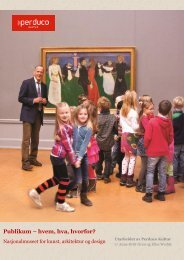Arts audiences: insight [PDF 6.5 MB] - Arts Council England
Arts audiences: insight [PDF 6.5 MB] - Arts Council England
Arts audiences: insight [PDF 6.5 MB] - Arts Council England
- No tags were found...
Create successful ePaper yourself
Turn your PDF publications into a flip-book with our unique Google optimized e-Paper software.
Time-poor dreamers 7% of English adultsEarly or mid career, often juggling workand family commitments, Time-poordreamers are busy, budget-consciousand short-term oriented, living in themoment while aspiring for more intheir life and career in the future. Ofteninfluenced by advertising, they areimpulsive shoppers and spend readilyon clothing while saving on householdnecessities.Their leisureTime-poor dreamers spend a lot of theirfree time out and about. They meet theirfriends in bars or pubs, sometimes playinga game of darts or pool. Many of themplay the Lottery regularly, in the hopes of‘striking it rich’.They like shopping for bargains – youmight typically find them shopping at Argos,JJB Sports, Primark, George at Asda orIceland. Occasionally they might also goto the cinema.When at home they prefer to wind downand relax by watching TV. Busy at work and,for many, taking care of their children, theyhave little time for cooking and often optfor take-away foods.Their arts• Time-poor dreamers engage with popularculture by listening to music charts on theradio (eg Hit 40 UK), going to the cinemaand watching TV• they do not currently attend arts eventsor actively take part in any creativeactivities• the majority of them cite lack of timeas their reason for not attending orparticipating in the arts – the arts are nota priority for them and do not naturally fitinto their current lifestyleEngaging with Time-poor dreamersAs many of them have children, Time-poordreamers may respond to a family-focusedarts offer that provides a fun activity forthe kids while allowing the parents to havea break and relax. Competitions or talentshows and activities involving celebrities, orlinked to relevant brand names might alsobe good ways of engaging with this group.In general, positioning the arts as something‘fun’ or as ‘entertainment’ is likely tobe more effective than emphasising theaesthetic, intellectual or educational aspectsof artistic experiences. Other considerationscould include:• location: use local venues or locationswhich they already frequent(eg shopping malls)• format: keep the activity informal,perhaps allowing people to drop-in ortry doing something for a short time only• cost: to lower the financial risk to engage,consider making activities affordableor freeTheir demographics• a younger segment, with two fifths aged16–34• two fifths – a higher than averageproportion – have one or more children inthe household• they are typically educated to a limiteddegree, working full time in a routine,semi-routine or a lower supervisory joband earning an average salary• most live in urban areas, with a fifth livingin London48 <strong>Arts</strong> <strong>audiences</strong>: <strong>insight</strong>


![Arts audiences: insight [PDF 6.5 MB] - Arts Council England](https://img.yumpu.com/45899288/48/500x640/arts-audiences-insight-pdf-65-mb-arts-council-england.jpg)



